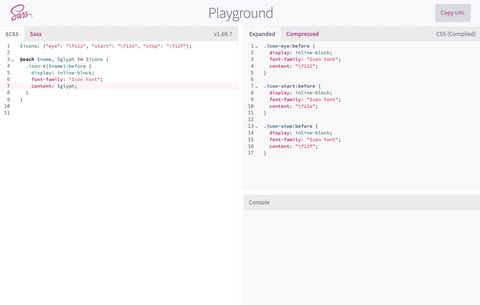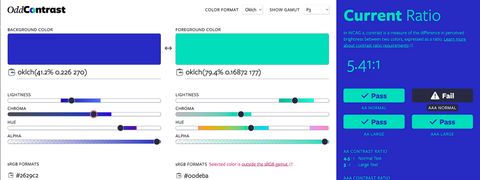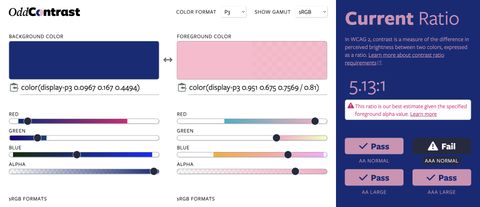Make the Web a More Colorful Place!
A guide to using new color spaces & formats with OddContrast
OddBird’s color tool not only checks contrast ratios, but supports the new CSS color formats and spaces.

You may not need anything more
When adding interactivity to a web app, it can be tempting to reach for a framework to manage state. But sometimes, all you need is a Proxy.
Recently, I was building the Playground feature on the Sass website. It’s an interactive feature built into a static Eleventy site, so we didn’t have a UI Framework already integrated.

Let’s take a look at the interactive parts of the tool. Users have three inputs:
From this, there are several side effects. Any time one of these changes, we need to recompile the Sass. We also need to update the hash in the URL, which allows users to share the state of the page.
If compilation succeeds, we can simply update the output value. If it fails, we need to display the error.
While this isn’t an extremely complex set of interactions, it’s enough that we want to be mindful of how we set this up. Essentially, we have three inputs and three outputs.
So, what is it that we actually need here?
At this point, there are a few options. A UI Framework like Svelte would provide an easy, centralized interface for reactivity, but comes with the long term update and maintenance costs of an extra dependency.
We could also add our logic directly in click handlers of our inputs. This is perhaps the most straightforward approach, but also is decentralized, and would come with a lot of code duplication.
A third solution is using a Proxy. We can store our data in a proxied object, and then intercept – or “trap” – the setters to trigger the reactivity.
const initialState = { input: '' };
const state = new Proxy(initialState, {
set(state, prop, value) {
const set = Reflect.set(...arguments);
console.log(`Setting ${prop} to ${value}`);
return set;
},
});
state.input = 'Hello!';
// "Setting input to Hello!"Every time we set the value of state.input, we log the prop and value. Note
that we use the proxied object state, and not the initialState object.
Because we are trapping set, we need to set the value with Reflect.set(). We
also need to return a Boolean specifying whether the set was successful.
const initialState = {
inputFormat: 'scss',
outputFormat: 'expanded',
inputValue: '',
compilerHasError: false,
};
const playgroundState = new Proxy(initialState, {
set(state, prop, value) {
// Set state first so called functions have access
const set = Reflect.set(...arguments);
if (['inputFormat', 'outputFormat', 'inputValue'].includes(prop)) {
updateCSS();
updateURL();
} else if (prop === 'compilerHasError') {
updateErrorState();
}
return set;
},
});This is a bit simplified from the full source code.
With this, we’ve achieved a few things. First, we have a central location for the data we need to access. Second, we have a central place to declare what happens when a value changes.
When a user changes the input format, we simply need to update the state with
playgroundState.inputFormat = 'sass'; and updateCSS and updateURL are
automatically called. We no longer need to remember to trigger the side effects
in each place where state is updated.
For this particular project, I only needed to trigger side effects, so I only
needed to use the set trap. One thing I’m interested in trying out in a future
project is using a get trap to set up a computed value based on other values
in the state.
const initialState = { input: '' };
const state = new Proxy(initialState, {
get(target, prop, receiver) {
if (prop === 'isEmpty') {
return target.input.length === 0;
}
return Reflect.get(...arguments);
},
});
console.log(state.isEmpty); // true
state.input = 'has a value';
console.log(state.isEmpty); // falseThis pattern would be useful when you need to access a value derived from other pieces of the state at a different point than when you set the state.
This isn’t a universal solution. If you have an existing library, use it. If you
find yourself abstracting out things like watch or computed for your proxy
state, you are starting down the road to developing your own framework, and it
might be a good time to pause and see if your application has grown complex
enough to bring in something more robust.
This pattern does work well if other files want to update or access the state in the store. However, you’ll likely want to contain side effect logic to the file where the state is defined. If you’re wanting to define side effects across files, you’d need to do that with callbacks, and ideally start looking for ways to abstract that out. At that point you’ll probably be happier reaching for another solution.

A guide to using new color spaces & formats with OddContrast
OddBird’s color tool not only checks contrast ratios, but supports the new CSS color formats and spaces.

hint popovers, position-area and more
We have been busy updating the Popover and CSS Anchor Positioning Polyfills, but there is still more we can do with your help.

Display color gamut ranges and more
OddContrast, OddBird’s color format converter and contrast checker, gets new features – including the ability to swap background and foreground colors, and display color gamut ranges on the color sliders. Contrast ratios now incorporate foreground color alpha values.